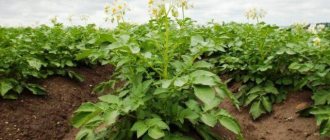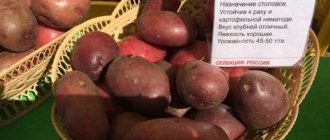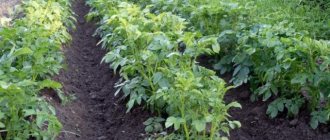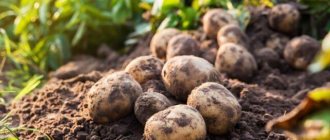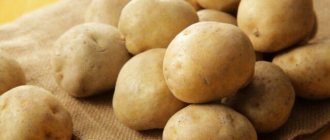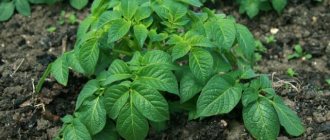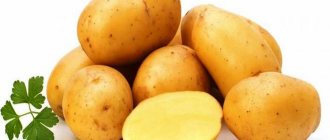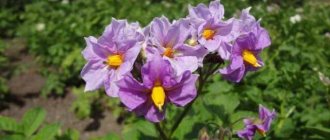Alvar potatoes are one of the best European crops in terms of taste and yield. At the same time, it is characterized by increased resistance to adverse external factors and rapid adaptation to any climatic conditions. This explains the growing popularity of this species among Russian gardeners. However, to achieve maximum productivity of the variety, it is necessary to follow the rules of planting and further care, so they need to be studied in advance.
Alvar potatoes are resistant to degeneration
History of origin
German employees worked on the development of this potato variety. The purpose of its creation was to obtain a type of crop that would be superior in characteristics and taste to the Desiree variety.
Selection work was carried out over ten years. And as a result of multi-stage selection, a variety was obtained that fully met the expectations of its creators. And in 1985, Alvar potatoes were officially registered in Germany.
It appeared in the State Register of Russia in 1999. The results of variety trials fully confirmed the declared characteristics of Alvar potatoes. And, judging by the growing popularity of the variety among gardeners, it really surpasses many well-known types of crops in productivity.
comparison table
Tuber weight
| Name of potato variety | Average weight (marketable in grams) |
| "Alvara" | 90–100 |
| "Desiree" | 50–100 |
| "Beauty" | 250–300 |
| "Labadia" | 100–160 |
| "Elmundo" | 100–130 |
| "Crown" | 75–130 |
| "Riviera" | 100–180 |
Productivity
| Name of potato variety | Productivity (in tons per 1 ha) |
| "Alvara" | 29,5–44 |
| "Desiree" | 13–38 |
| "Beauty" | 40–45 |
| "Labadia" | 29–46 |
| "Elmundo" | 25–34 |
| "Crown" | 43–65 |
| "Riviera" | 28–45 |
Starch content
| Name of potato variety | Degree of starchiness (in%) |
| "Alvara" | 13–14 |
| "Desiree" | 14–23 |
| "Beauty" | 14–19 |
| "Labadia" | 11–16 |
| "Elmundo" | 11–14 |
| "Crown" | 9–13 |
| "Riviera" | 13–16 |
Description of Alvara potato variety with photo
Alvar potatoes have characteristic differences in the appearance of bushes and tubers. This allows it to be unmistakably distinguished from other varieties.
Bush
Alvara is characterized by tall bushes of an intermediate type, the length of which reaches 60 cm. Each of them consists of 3-4 shoots, with a diameter of 0.8-1 cm. Initially, the stems are erect, but as they grow, they deviate slightly in different directions. The leaves of the Alvar potato are small, 6-8 cm long. They can be light or dark green in color. The edges of the plates have a slight waviness. The shoots are densely leafy at the top and bare at the bottom.
The root system of this type of crop is well developed. Under each bush, 8-14 large tubers are formed per season.
Alvar potato flowers are small, red-violet in color. They are collected in small inflorescences of 3-4 pieces. When planted in mid-May, the variety blooms in the second decade of June and lasts about 10-14 days.
Alvar does not produce berries
Important! To successfully grow these potatoes, crop rotation must be observed.
Tubers
The variety is characterized by a high yield of marketable tubers of about 85-90%. They are elongated oval in shape, aligned. Moreover, under one bush, potatoes grow almost the same size. The average weight of tubers varies between 90-140 g.
The peel is smooth, uniformly red in color. The eyes are superficial, unnoticeable, which minimizes waste during cleaning. The pulp is dense, light yellow in color, and does not darken when exposed to air. During the cooking process, Alvar potatoes are slightly overcooked. The starch content in its tubers is 12.8-14.1%. But this component accumulates gradually and reaches its maximum level at the end of the potato growing season.
Alvar tubers are resistant to mechanical damage
Diseases and pests, how to fight
Of the diseases, the crop is most susceptible to late blight. Affected leaves become brown, with a fluffy white coating; Dark spots appear on the tubers. To prevent the onset of the disease, the following preventive measures must be taken:
- observe crop rotation;
- maintain a large interval between ridges and tubers;
- hill up bushes;
- treat tubers with a disinfectant before planting.
The main potato pest is the Colorado potato beetle. In order not to lose the harvest, the insect is collected manually, or the bushes are treated with insecticides several times a season. Another common crop pest is the mole cricket, which can completely eat up the tubers. To combat it, chemicals are used in granules, which are poured into the openings of the passages.
Important! When spraying bushes with fungicides and insecticides, safety precautions must be observed.
The main pest of potato bushes is the Colorado potato beetle.
Potatoes called Alvara are one of the best red-skinned varieties. It is tasty, does not become overcooked and does not change color when cooked. The culture is unpretentious in care and resistant to many diseases. Having planted tubers on the plot and properly cared for them, the gardener will certainly reap a good harvest of tasty and healthy vegetables.
Characteristics of Alvar potatoes
To assess the productivity of this type of crop, it is necessary to familiarize yourself with its characteristics. This will also make it possible to understand what conditions are necessary for the Alvar species in order to achieve maximum efficiency when growing it.
Taste qualities of Alvar potatoes
The taste of this potato is rated as excellent at 4.8 points out of five possible. The tubers do not lose their shape during heat treatment and look appetizing.
This variety is suitable for:
- salads;
- boiling in its purified form and “uniform”;
- baking;
- frying
It is also used for processing purposes. Alvar potatoes are suitable for making chips, crackers, starch, and freeze-dried purees.
Ripening time
This species is considered mid-early. The duration of its growing season from planting to harvest is 75-80 days. Therefore, you can dig up tubers for long-term storage in mid- to late August. However, the timing may vary depending on the climate of the growing region.
Productivity
Alvar potatoes are characterized by high yield. Varietal tests have shown that, given favorable conditions, its productivity reaches 295-500 kg per hundred square meters, which is an order of magnitude higher than the generally accepted norm.
Where is it grown?
The variety is recommended for cultivation in the North Caucasus and North-Western regions. But, judging by the reviews of gardeners, it shows high productivity in other regions of Russia, if proper care of the crop is provided.
Disease resistance
Alvar potatoes are highly resistant to viruses. It also does not suffer from scab, golden nematode, or cancer, but its tops and tubers can be affected by late blight. Therefore, when growing Alvara, you should not neglect preventive treatments of bushes with fungicides throughout the entire growing season.
Potatoes through my eyes... How I planted them and chose varieties. Part 2
Potato varieties
According to ripening time, all varieties are divided into 5 groups:
- early with a ripening period of 80-90 days
- mid-early (90-115 days)
- average (115-125 days)
- medium-late (125-140 days)
- late (more than 140 days)
When selecting a variety, these terms must be taken into account in order to regulate the time for germination of tubers and planting them in the ground.
Using the right technique, you can reduce germination time and speed up the emergence of seedlings. The result is early and tasty tubers. It should be noted that these dates are subject to change, just like our weather in temperate climates. Typically, tubers ripen faster, this is confirmed every year. In the photo there are 5 varieties that I highlighted due to their taste. In the first part of my story, I mentioned the “Rosara” with large oval pink tubers. It contains a low percentage of starch, so the pulp takes on the taste of undercooked potatoes, the potato pieces become transparent and hold their shape perfectly. It is ideal for making chips. In contrast, the 5 varieties in the photo are high-starch.
Ads by
"Adretta"
“ Adretta ” is a mid-early table variety.
Bred in Germany. It appeared in Russia in the nineties and quickly spread due to its excellent taste, which made it unlike other varieties. Adretta is characterized by fast growth, early tuberization and high yield. It blooms with large white flowers and produces numerous berries. You can select early tubers from under the mulch as early as 70 days after planting. The bushes are erect, with multiple stems, the leaves are large, light green. When using mulch with further “unhilling”, the stems reach a height of more than a meter. Therefore, in ordinary beds it is necessary to make the distance between the rows at least 90 cm. “Adretta” in the basement for storage
Starch content - up to 17.8%. The tubers are round, yellow, the flesh is light yellow. The eyes are small. During storage, the peel is covered with a mesh pattern. Sometimes I heard that Adretta is not kept very well. Under the right conditions, it lasts until spring. I think the reason lies only in the storage conditions! This variety is resistant to cancer pathogens and relatively resistant to viruses. Susceptible on tops and moderately on tubers to the causative agent of late blight. Suitable for almost all cultivation zones.
Taste is the advantage of “Adretta”. The tubers cannot be peeled or boiled; they are not at all suitable for first courses, since the potato pieces do not hold their shape. But for puree soups this is the most suitable option! “Adretta” is the queen of steaming “in uniform”. You can bake raw Adretta, just don’t actively turn it over. It cooks well just in a saucepan with a small amount of water at the bottom and over low heat. By the way, it cooks very quickly. Then, peeled and placed on a baking sheet in the oven or simply in a frying pan, it shows itself.
Boiled and fried “Adretta” Tip! Asafoetida combined with shamballa or fenugreek leaf helps digest starchy foods, as do cumin and ground coriander. When heated in oil, the aroma of onion and garlic inherent in asafoetida spreads far. This cooking method allows you to get another potato dish that is new and tasty.
Asafoetida and Shambhala leaf Shambhala seeds germinate well, you can cut and dry the greens. There are also ready-made bags of dried fenugreek. Asafoetida, unfortunately, is now produced with lids that do not close tightly (left). Therefore, it is better to additionally place it in the package. On the right is the packaging that was there before.
All young summer tubers are tasty, it is difficult to distinguish them, so I brought them from the basement and boiled them now that they were ripe enough. Then they cooled down, this is the only way to experience the real taste of potatoes.
Boiled tubers None of the varieties turn dark after boiling. Everyone was given separate cooking utensils; mixing of flavors was excluded. It’s hard to work with tasters these days; if you invite them, they’ll suddenly misunderstand...))) Therefore, I rely on the taste of my husband, a big “latter” of potatoes, especially boiled ones. Just such a taster can carry out an organoleptic examination objectively. Well, I’ll try again... Moreover, we need to determine which varieties we will leave in the garden.
"Bronnitsky"
The next variety - "Bronnitsky" - is mid-season, spreading, tall, forms many stems , blooms well with blue-violet flowers and produces berries.
The taste is excellent, starch content is up to 16%. The tubers are oval-round with a smooth light yellow skin. “Bronnitsky” The eyes are quite “recessed” and numerous. When used in the kitchen, this feature interferes if you need to quickly remove the peel with a vegetable peeler or knife. This variety is rarely sold in markets, all because of the shape of the tuber and eyes. When boiled with the peel, the tuber is easy to peel; its skin is very thin.
"Bronnitsky" boiled
Very aromatic potatoes, you rarely see one like this these days. Its advantage is its versatility in various dishes and excellent taste. It stores well, is resistant to cancer, relatively resistant to scab, and not resistant to potato nematode. Recommended for the Center of Russia, the Volga region, and the Krasnoyarsk Territory.
"Blue"
“Golubizna” variety is a mid-season, tall, erect bush, with many stems and dark green leaves.
It blooms for a long time with blue flowers, but does not form berries. The peel is white mesh, the flesh is white. The tuber is round with a sharp tip, numerous small eyes. The starch content is high - up to 19%. Drought resistant. Recommended for the Center of Russia, perhaps that is why the variety did not reveal its advantages. There is no potato aroma when cooking. Productivity is much lower than "Adretta" and "Bronnitsky". 10-12 tubers is not enough. Blueberry tuber, raw without peel
Frying Blue and Gourmand slices
For greater clarity, I peeled two tubers - “Blue” and “Gourmet” and fried them a little. I will write about purple potatoes of the “Gourmet” variety below. They don't fall apart, they both keep their shape.
"Lyubava"
The variety "Lyubava" is early ripening.
The taste is stated to be good. But despite the declared “excellent” taste of “Golubizna,” it is precisely “Lyubava” that has a potato spirit when cooked. "Lyubava" Bushes of medium height, semi-erect. The tubers are oval-round with eyes of medium depth. The peel is red, rough to the touch, the flesh is white. Starch content up to 16.9%. The advantage of the variety is high yield and uniform formation of tubers. Already on the 45th day it can produce an early harvest. So I pulled out the first tubers from the box bed.
“Lyubava” baked with rutabaga in cream in a country electric oven
You can boil, fry, and stew. The variety is resistant to the potato canker pathogen, but susceptible to the golden nematode. Stores perfectly.
"Sorcerer"
Variety “Sorcerer” is a mid-early variety, suitable for table use.
The bush is erect. The blooming white flowers of "Sorcerer" spread a stunning aroma throughout the entire area. We have been observing this amazing phenomenon for two years. “Sorcerer” Tubers are oval, the skin is smooth, yellow. The pulp is white. Starch content - up to 15%.
Boiled “Sorcerer” When used in soups and stewing, the pulp does not boil softly:
“Sorcerer” The variety stores well. Resistant to the causative agent of cancer, late blight, susceptible to golden nematode. Not afraid of drought. Recommended for cultivation in the Northern, Northwestern and Middle Volga regions.
"Gala"
Variety "Gala" - German selection.
It quickly gained popularity due to its productivity, uniform and even tubers with shallow eyes. Externally, the yellow round-oval tubers are very similar to “Adretta”. But there is less starch - 13%. "Gala"
The flesh is also yellow. The variety is universally used, stores well, and is easily transported. Productivity is high. This is why we love farmers... For a beginning summer resident, “Gala” is a lifesaver. An early ripening variety, semi-erect, of medium height with large bright green leaves and white flowers. Not picky about soils. When mulching and “unhilling,” the length of the stems did not increase, like in “Adretta.”
“Gala”, “Red Scarlet” and “Madam” The variety “Gala” is resistant to diseases. But it is prone to black scab, that is, rhizoctonia, a fungus that affects the lower part of the stem. I planted this variety only in the 2016 season; my potatoes were spared this misfortune.
The flesh and peel of “Gala” are yellow and do not darken after cooking. The tuber is easy to cut after boiling, there is no sticking to the knife blade, unlike the starchy “Adretta” and “Golubizna”, which is very convenient for salads and vinaigrettes.
These varieties are boiled for testing, but there is no potato aroma. The pulp is quite soft; there is a cavity in the middle of the tuber. In cooking, "Gala" is universal. As they say in the old play: “Even from an old rooster you can make satsivi”))) With seasonings, with spices, with spices it can be fried, boiled, stewed, and baked. The bushes, by the way, produced 20-22 tubers.
"Madam"
The “Madam” variety cannot be bad with such a name.
Medium-early, highly erect bush, externally reminiscent of “Adretta”. I was surprised by the harvest, the tubers were large, pot-bellied, or rather oval-round, clean, smooth, yellow in color. The pulp in its raw form is cream-colored with a slight yellowish tint; after cooking it becomes more yellow. The starch content is high - up to 19%. Harvest - up to 25 tubers per bush. Well kept. Resistant to cancer, nematode, scab, viruses and late blight. It holds its shape when cooked. Suitable for any dishes. “Madam” baked with porcini mushrooms I would like to find a flaw! If the eyes were like Gala’s, it would be possible to clean them automatically.
"Red Scarlet"
The “Red Scarlet” variety is a productive “Dutch”, early ripening, which is sold not only by supermarkets, but also by shops in remote villages.
It is stored perfectly, can also be transported, and is not afraid of falls or bruises. Its pink-red, elongated oval tubers have a richer color than those of Rosara. The eyes on them are superficial, this is convenient for technical processing, like the “Gala”. The bush is low and erect. The pulp of the tuber can be either white or light yellow. The variety is very unpretentious and can withstand drought. The taste definitely didn’t suit us; there was no potato aroma at all. The husband expressed himself with characteristic directness: “Soap!” This variety, like “Rosara”, is suitable for making chips and frying (starch 15%) Suitable for the center of Russia and the southern region.
"Gourmet"
Variety “Gourmet” is a mid-early variety with purple flesh.
The bush is semi-erect. "Gourmet" on the left and "Fima" on the right
It blooms with white flowers and produces berries. Harvest 12-14 tubers. Contains antioxidants, so it is useful for dietary nutrition and use for cosmetic purposes. I didn’t get to the masks... The tubers were of different sizes, and as it turned out, the color intensity of the pulp also differed very much from each other.
“Gourmet” I tasted it. Didn't like the taste. But useful, as they say. It is believed that it can be consumed raw. I agree that potatoes lose their value when cooked. And if you consider that the most valuable thing about a tuber is the thin layer under the skin, is it worth growing it?!
The cut of the “Gourmand” tuber was more purple. It is better to boil over steam in the peel, but the color also changes in this case.
Boiled over steam and peeled “Gourmet” In any case, whether during cooking or frying, the tubers partially lose their color. Low starch content can be immediately determined by taste. Thanks to this property, Gurman is suitable for diabetics, as well as those prone to excess weight.
"Fima"
"Fima"
The “Fima” variety is also tubers of different pulp colors.
I’m planning to overcome myself and eat it raw in salads in the fall. “Fima” baked with zucchini, onions and porcini mushrooms. Today I baked raw pieces, I didn’t boil the tubers first, there is a potato taste and smell too. But only the yellowness of the zucchini brightened the dish. Dill was sprinkled later than the photo.
This season I grew purple carrots, and I really liked the taste.
Purple carrots
Good in salads raw, it turned out to be sweeter than regular carrots and even the vaunted yellow ones. And with colored potatoes we are still deciding whether to plant... and if we plant, then how many. Perhaps the time will come when breeders will develop tasty varieties of colored potatoes. After all, the familiar one appeared quite recently, relatively speaking, of course. Here are pages from the first statistical work in Russia in the mid-nineteenth century:
About the food of peasants 150 years ago in the Kostroma province About potatoes This is taken from “Materials for statistics and geography of Russia, collected by officers of the General Staff.” 1861
In any case, the berries are collected and the seeds are dried. Of course, when choosing other potato varieties, we will be guided by the presence of good and excellent taste of the tubers.
You need to try to grow different varieties on your own land, this is the only way to find the right one and exactly “yours.” Only the choice must begin with recommendations for potato zoning.
I wish everyone an error-free choice of varieties and a healthy harvest on healthy land!
Pros and cons of the variety
This variety, like others, has certain advantages and disadvantages. Therefore, it is necessary to familiarize yourself with them in advance in order to know the strengths and weaknesses of Alvar potatoes.
The variety shows good performance even on infertile soil
Main advantages;
- excellent taste;
- high stable yield;
- resistance to degeneration;
- undemanding to soil composition;
- has excellent commercial qualities;
- versatility of use;
- good keeping quality;
- high natural immunity;
- suitable for transportation.
Flaws:
- requires preliminary germination before planting;
- needs to observe crop rotation;
- susceptible to late blight.
Advantages and disadvantages
Professional vegetable growers highlight the following advantageous features of the Alvara potato variety:
- Early ripeness.
- High yield.
- Growth stability.
- Multituberism.
- High commercial quality.
- Excellent taste properties.
- Versatility.
- High immunity to viruses, potato cancer, nematodes.
- Long shelf life with little loss.
- Duration of cultivation without frequent replacement of seed material.
Disadvantages of the Alvara variety:
- High cost of planting tubers.
- Low resistance to late blight.
Landing rules
Alvar potatoes are suitable for open areas that are well lit throughout the day. The crop can be grown in sandy, loamy soil and black soil with a neutral acidity level. It is recommended to prepare the area for planting in the fall. To do this, you need to dig it up and add 5-10 kg of humus per square meter. m. It is also recommended to add 300 g of wood ash for the same area size. With the arrival of spring, the soil on the site needs to be loosened to a depth of 10-15 cm to enrich it with oxygen. This will allow the root system to fully develop.
Alvar potato tubers require mandatory germination before planting. Therefore, three weeks before the procedure, they need to be brought into a room with a temperature of +15 ° C and laid out in one layer. It is recommended to rotate the planting material periodically to ensure uniform development of sprouts. By the time of planting, their length should be 1.5 cm.
The optimal depth for planting tubers is 8 cm on light soils and 6 cm on heavy soils. The distance between the holes should be 35 cm, and in the rows it is recommended to maintain a distance of 70 cm.
Important! It is recommended to update planting material after five years to maintain varietal qualities.
Rules for planting potatoes in open ground
Although Alvara is a foreign potato, it is not at all difficult to grow it in our area. It responds well to standard agricultural practices. There are several methods for planting potatoes, but the most popular remains the traditional one (in separate holes).
Also learn about how to prepare potatoes for planting.
Optimal time for planting
Potatoes are planted in open ground in different regions at different times, mainly in April or May. The main condition is that the soil temperature at a depth of 10 cm should not be lower than 8°C. The soil warms up to this temperature if the average daily air temperature does not drop below +10°C for several days. This is the most comfortable temperature for germination and rooting of potato seeds.
In cold soil, tubers can become sick. In addition, at this temperature the soil becomes mature, that is, not wet, not dry, but moderately moist. If the earth forms a lump in your hands, but then quickly crumbles, then this is a sign of moderate humidity.
Site selection and soil preparation
One of the significant advantages of Alvar potatoes is its undemandingness to soil. It is guaranteed to produce a harvest on almost any type of soil: chernozem, loam, sandy loam, podzolic, sod-podzolic, peat-gel, etc. Of course, the variety shows the best results on fertile, light and slightly acidic soil.
How to care
Alvar potatoes are drought resistant. But with a prolonged lack of moisture in the soil, its productivity decreases. Therefore, it is recommended to water as needed, soaking the soil by 10 cm.
Ten days after planting, the soil must be loosened to prevent the formation of a crust on its surface. Its depth should be 1.5-2 cm. The first hilling for Alvar potatoes is recommended when the shoots are 17 cm high, and the second - two weeks later. In addition, it is necessary to weed as the weeds grow until the rows close together.
Alvar potatoes respond well to feeding. At the initial stage of growth, you can use organic matter: chicken manure 1:15 or mullein 1:10, and in its absence you need to use ammonium nitrate 30 g per 10 liters of water. It is recommended to do the second and third feedings at the stage of formation of inflorescences and after they wither. At this time, potatoes must be fertilized with 30 g of superphosphate and 25 g of potassium sulfide per bucket of water.
Under each bush you need to pour 0.5-1 liters of nutrient solution, taking into account its stage of development
Alvar potatoes may suffer from the Colorado potato beetle. Therefore, when the first signs of the pest and its larvae appear, the bushes must be treated with an insecticide. If necessary, the procedure is repeated throughout the growing season, alternating drugs.
Important! Starting from the end of June, nitrogen fertilizers cannot be applied to the soil, as this will lead to excessive growth of tops to the detriment of yield.
Care
The Alvara potato variety is quite unpretentious and guarantees a good harvest even with insufficient proper care. To form a full harvest of tubers with high marketability, you must follow the following care recommendations:
- Hill up potato plantings in a timely manner in the initial growth phase, this will protect them from the effects of age-related spring frosts. The first time they hill up when the potato tops reach a height of 15-20 cm, the second time they hill up after two weeks;
- The first time fertilizer is applied during the growth period of the tops, using urea and mullein or bird droppings. The second time is fed during the budding period, using potassium sulfate and wood ash. The third feeding with superphosphate and nitrophoska is carried out in the flowering phase;
- Watering potato plantings should be quite rare, but plentiful;
- During the entire growing season, remove weeds in a timely manner, and then superficially loosen the soil between the rows.
REFERENCE: The soil should be wetted by 0.4-0.5 m or from the ratio of 12 liters of water for each bush.
Harvest and storage
It is recommended to dig up Alvar potatoes when the shoots suddenly wilt, which indicates the maturation of the tubers. This usually occurs in the first or second ten days of August, depending on the growing region. Harvesting is recommended in clear, dry weather. The tubers must initially be laid out on the area to dry for two hours, and only then transferred indoors.
After four weeks, the crop must be sorted and sorted out, defective, small and planting specimens. After this, Alvar potatoes can be transferred to the basement for long-term storage. Optimal storage conditions: temperature +4-6 °C and humidity within 70-75%. With this regime, the crop is well stored for ten months.
The keeping quality level of the variety is 90%
